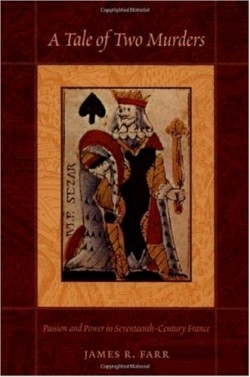A Tale of Two Murders
Passion and Power in Seventeenth-Century France
This meticulous account of crime, courtroom drama, and punishment in seventeenth-century Dijon, France is a case study in the best sense of the term—and what a case! “The Giroux Affair” caused a sensation in its time with its accusations of adultery and multiple murder at the highest level of the provincial nobility, and modern readers as well will find a full measure of passion, deadly rivalry, political intrigue, and general hugger-mugger played out against the same backdrop as Dumas’s fictional Three Musketeers.
The defendant was one Philippe Giroux, a judge of the highest royal court of Burgundy, who with several henchmen was alleged to have murdered his equally eminent fellow judge (and cousin) Pierre Baillet and Baillet’s valet in 1638. Adding spice to this bloody stew, Giroux was said to be pursuing a passionate affair with the victim’s beautiful wife; his own wife and her doctor had died under suspicious circumstances, and rumor had it he’d also tried to poison his mother-in-law. But no bodies were found, so Giroux’s accusers could not conclusively prove murder, although circumstantial evidence seemed overwhelming. The investigation and trial lasted four years, replete with reversals worthy of John Grisham, and came to involve no less than the King of France and Cardinal Richelieu, just two of a supporting cast that encompasses characters from rogues to royalty.
Because of the Giroux Affair’s high profile, it was extraordinarily well documented by the court, with each witness’s testimony carefully preserved; moreover, since most key figures were literate, a wealth of secondary material has also survived. Oddly, this presents the author with a paradoxical dilemma: so colorful a tale is a novelist’s dream that cries out for embellishment, yet the unvarnished record is compelling enough for a scholarly treatment that repays in intellectual substance what it sacrifices in swashbuckling but imagined flourishes.
Farr opts to stay scrupulously close to the facts, and readers with a serious interest in early modern Europe will be glad that he did. A professor of history at Purdue University and a former Guggenheim Fellow whose previous books include two on life in Burgundy during the same period, he displays both a command of the era and the society and a knack for illuminating the complex interactions of royal power, aristocratic privilege, and the rule of law. For example, Farr describes a legal system sophisticated enough to stipulate recusal for judges biased by family ties or longstanding enmities, and to draw a sharp distinction between genuine probative evidence and “common knowledge” (which in gossipy Dijon was both pervasive and apparently persuasive). Yet he also portrays a culture still medieval enough that torture was lawful under certain circumstances, and still unsettled enough that key witnesses often disappeared—some paid off, others poisoned.
The author is equally lucid in showing how this unusually dramatic case was emblematic of seventeenth-century France rather than a lurid anomaly. He uses it to throw French society, justice, and politics into high relief, and though he focuses mainly on its representative qualities, he is also careful to note where it departs from the norm. Among its many interesting aspects, the Giroux Affair is an early example of “trying a case in the press,” using so-called factums, widely distributed pamphlets supporting one side or the other; although these had no legal standing, they helped sway public opinion, which in turn had at least some influence on strictly judicial considerations.
The facts themselves provide considerable drama, and liberal quotations from contemporary records lend authenticity to the atmosphere, as do a scattering of maps, illustrations, and photographs. Non-specialist readers may sometimes wish for more descriptive detail, but Farr’s core constituency will appreciate his concise and direct approach, refreshingly free of speculation and the “surely-he-must-have-thought…” intrusions of less rigorous historians. Finally, a cogent closing essay summarizes the historical lessons to be drawn from the story, and twelve pages of notes and sources complete a thoroughly well-executed effort.
Farr wisely chooses not to advance an opinion on the ultimate truth of the murders, and in fact, the circumstantial nature of the case against Giroux lends poignancy to its uncertain conclusion. For while most readers will likely find him guilty (as the court finally did in 1643), he himself steadfastly maintained his innocence from the very start and in the end went to the scaffold with great courage. In that Age of Faith, when even confirmed villains could redeem their souls with a deathbed repentance, Philippe Giroux’s refusal to confess in extremis leaves the haunting suggestion that perhaps he was blameless after all, however improbable it may seem.
Reviewed by
Peyton Moss
Disclosure: This article is not an endorsement, but a review. The publisher of this book provided free copies of the book to have their book reviewed by a professional reviewer. No fee was paid by the publisher for this review. Foreword Reviews only recommends books that we love. Foreword Magazine, Inc. is disclosing this in accordance with the Federal Trade Commission’s 16 CFR, Part 255.

